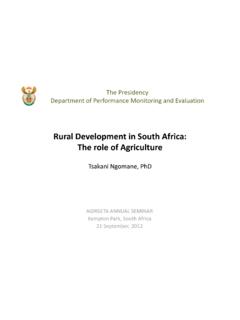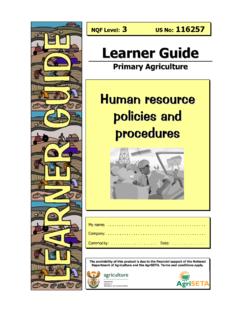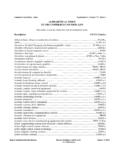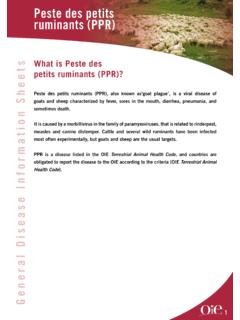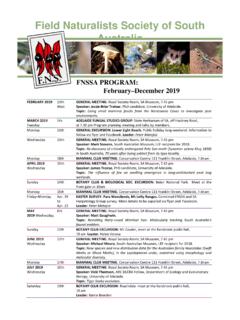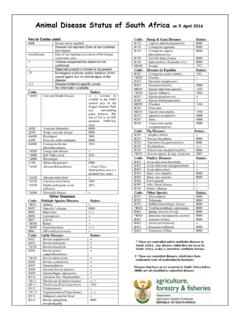Transcription of The pprreevvention and treatment of animal diseases
1 AAsssseessssmmeenntt GGuuiiddee PPrriimmaarryy AAggrriiccuullttuurree TThhee pprreevveennttiioonn aannddttrreeaattmmeenntt ooff aanniimmaallddiisseeaasseess NQF Level:3 US No: 116219 The availability of this product is due to the financial support of the National Department of Agriculture and the AgriSETA. Assessor: .. Workplace / Company: .. Commodity: .. Date: ..Explain the prevention and treatment of animal diseases Primary Agriculture NQF Level 3 Unit Standard No: 116219 22 Version: 01 Version Date: July 2006 BBeeffoorree wwee his assessment guide contains all necessary activities and instructions that will enable the assessor and learner to gather evidence of the learner s competence as required by the unit standard.
2 This guide was designed to be used by a trained and accredited assessor whom is registered to assess this specific unit standard as per the requirements of the AgriSETA ETQA. Prior to the delivery of the program the facilitator and assessor must familiarise themselves with content of this guide, as well as the content of the relevant Learner Workbook. The assessor, facilitator and learner must plan the assessment process together, in order to offer the learner the maximum support, and the opportunity to reflect competence. The policies and procedures that are required during the application of this assessment are available on the website of the AgriSETA and should be strictly adhered to. The assessor must familiarise him/herself with this document before proceeding.
3 This guide provides step-by-step instructions for the assessment process of: This unit standard is one of the building blocks in the qualification listed below. Please mark the qualification you are currently assessing, because that will be determined by the context of application: Title ID Number NQF Level Credits Mark National Certificate in animal Production 49048 3 120 U National Certificate in Plant Production 49052 3 120 U Please mark the learning program you are enrolled in: Are you enrolled in a: Y N Learnership? U U Skills Program? U U Short Course? U U TT Title:Explain the prevention and treatment of animal diseases US No:116219 NQF Level: 3 Credits: 5 PPlleeaassee NNoottee:: This Unit Standard 116219 Assessment Guide must be read in conjunction with the generic Assessor Guide as prescribed and published by the AgriSETA.
4 NNoottee ttoo AAsssseessssoorr:: If you are assessing this module as part of a full qualification or learnership, please ensure that you have familiarized yourself with the content of the qualification. Explain the prevention and treatment of animal diseases Primary Agriculture NQF Level 3 Unit Standard No: 116219 33 Version: 01 Version Date: July 2006 The facilitator will arrange an outing to a farm or farming enterprise. Basic restraining exercises will be demonstrated to you and then you will be given the opportunity to restrain the animal yourself. Make sure that you know how the facility operates and how the restraining apparatus works before you attempt the procedure. Small animals like sheep and goats can also hurt the operator as well as themselves.
5 Make sure you approach the animal in the correct way. Warning : When using drenching equipment with an immobilizer the animal will be in an immobilized state because of an electric stimulus that override the animals own nerve impulses. If you want to administer something orally remember that you can administer it in the windpipe and that will damage the lungs. This procedure is normally done by a veterinary surgeon. Farmers use neck clamps for drenching large animals like cattle. Model Answer(s): There are different methods used to restrain animals and the answer will vary accordingly. The facilitator must design a model answer relevant to the experience of the learner. Instructions to learner: Practical activity 11 SSOO 11 Learner Guide: Page 11 Facilitator Guide: Page 10 MMyy NNootteess.
6 Explain the prevention and treatment of animal diseases Primary Agriculture NQF Level 3 Unit Standard No: 116219 44 Version: 01 Version Date: July 2006 Arrange an outing to a farmer to demonstrate the treatment of: External parasites (dipping). Internal parasites (dosing). Dosing remedies, tablets and dry powder. Vaccinating animals. Using of a gag. Make sure of the handling of the insecticides and drenching equipment that the instructor used. Note the sequence of the whole procedure. How the strength of the concentration of the insecticide (or dip) is kept at an effective level. How the vaccines are care for. The calibrating of the equipment. Write short notes on your observation of the procedures and hand in as part of your portfolio of evidence.
7 Model Answer(s): The learners notes should include all the key factors associated with the specific treatment and should also include practical hints as performed in the practical. Instructions to learner: Practical activity 22 SSOO 22 && 33 Learner Guide: Page 19 Facilitator Guide: Page 12 MMyy NNootteess .. Explain the prevention and treatment of animal diseases Primary Agriculture NQF Level 3 Unit Standard No: 116219 55 Version: 01 Version Date: July 2006 Do research in the local co-operatives and shops that sell animal remedies and vaccines to the farmer. Gather as much information on the diseases that might occur in your region. Certain diseases like bluetongue, Rift Valley fever and Wesselsbron may only occur when certain climatic changes takes place but the vaccine must be used much earlier to ensure that the animal develop immunity.
8 The vaccination of such diseases must be planned because pregnant animals cannot be vaccinated. Some of the vaccines like Bluetongue also comes in more than one strain and must also be vaccinated over a period of a month and a half to incorporate all the strains. Some of the vaccines can be vaccinated simultaneous with others and some not. The same rules apply when controlling ticks. The ticks that cause diseases like Heartwater and other tick borne diseases do not occur all over the country. So the dipping program of farmers where these diseases occur will differ from other programs. After all the relevant information is collected a management program must be developed for a farm. That must include: The mating season. The program for dipping or treating the animals for external parasites.
9 The dosing program for the control of internal parasites. The vaccination program for immunising the animals against the diseases that occur in your region. The expected season when the offspring of the animals will be born. If there is a seasonal occurrence (winter or summer draught) you can even include a supplementary feeding programme. There are a lot of animal pharmaceutical companies that supply these programs. You must ensure that this program is applicable in your area. After you have finished the program, you must discussed it in class and hand it in as part of your portfolio of evidence. Model Answer(s): This answer will vary for different regions but must include all the above criteria. Instructions to learner: Research activity 33 SSOO 44 && 55 Learner Guide: Page 41 Facilitator Guide: Page 14 Explain the prevention and treatment of animal diseases Primary Agriculture NQF Level 3 Unit Standard No: 116219 66 Version: 01 Version Date: July 2006 SSuummmmaattiivvee TTeesstt aanndd AAttttiittuuddee && AAttttrriibbuuttee EEvvaalluuaattiioonn efore the knowledge test is undertaken, the learner must be reminded of what is expected from him / her in terms of summative and reflexive competence.
10 Read and explain to the learner, the Preparation for Your Final Assessment section in the learner workbook. Learners and assessor should sign off this section to acknowledge that this step was completed. Please set up a knowledge test from the questions given as a guideline to learners and supply each learner with a test sheet. Supply each report with the following heading: Questions Model Answers 1. What is an immobiliser? An electric apparatus that override the nervous system of the animal and enable the farmer or veterinarian surgeon to treat the animal . 2. How would one use an immobiliser? The handler will learn from experience which level settings are the ideal for his animals. Suggested settings are as follow: Bulls : 8 or less Cows : 10 to 12 Calves : 8 to 10 It is advisable to have the level control set on zero when switching-on and then gradually increasing the level until the animal is fully immobilised.
